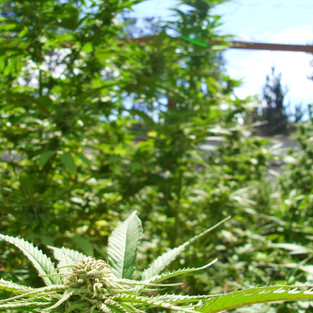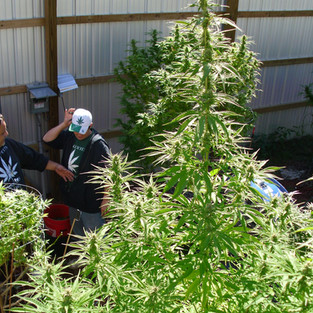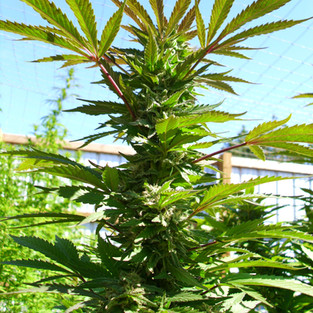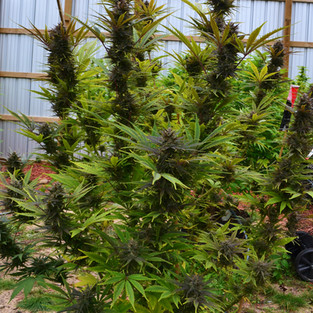It is that time of year when outdoor cannabis farmers are planning their spring crops and picking out what strains to run this season. Some cannabis strains do very well outdoors while others do not. Knowing the difference between these strains can make or break any outdoor operation. Getting our plants large enough before we place them outside here in Michigan is crucial to obtaining larger yields per plant. Knee high to waist high plants ready to be in the ground by June 1st is a good rule of thumb for most Michigan outdoor grows. This requires some planning to be ready in time. Most farmers we know are selecting genetics in January and February to get started by March 1st on indoor cultivation of their plants intended to go outdoors in the spring. This can be the difference of yielding a few ounces per plant vs a few pounds per plant. Get your plants started in time!

If you are looking for proven outdoor genetics that grow well outdoors here in Michigan (which means they grow well anywhere), by farmers that have first hand experience, look no further. These strains are potent, full of flavor, and offer above average yields on outdoor plants. These plants will flower in 8 weeks or less, kick into flowering early in the season, and finish early enough to harvest before the risk of frost.

All of our current strains do very well outdoors here in northern Michigan. If a plant does well here, it will do well almost anywhere. Northern Michigan has short summers followed by a usually wet and cold fall. Growing strains that finish flowering early is important here.
After we choose our genetics, the next most important decision is what soil or grow medium we are going to use. We prefer to dig holes that are 3'x3'x3' or 1 cubic yard and amend the soil with our own Smoking Tomato soil. You can fill the entire hole or just part of it and mix it in with the original soil. This will provide all of the nutrients and microbial life required for your plants to thrive. Literally just add water and watch your outdoor plants flourish.
Growing marijuana outdoors is great because you won’t need to spend a ton of money on it and you can rely on the power of the sun. If you have access to a sunny spot in a private yard or even a balcony, terrace, or rooftop, you can grow weed outside. You will be tied to the sun and the seasons and local weather, but you won’t have to spend a bunch of money on equipment and utilities like indoor growers.
If you’re growing cannabis outdoors, it’s great to find a community of cannabis growers in your area to see how others are growing in your specific climate. Local climates vary, so it can be helpful to see what strains thrive where you are, and also when other growers are popping seeds, harvesting, and more. You can also join online forums or Social media groups, but a great place to start is your local grow shop.
Benefits of growing marijuana outdoors
Low costs
Relying on the power of the sun, you won’t need to spend a ton of money on an outdoor grow. You’ll need some soil, fertilizer, seeds or clones, and maybe a small greenhouse to get them started. You won’t need to pay for electricity for lights, AC units, or dehumidifiers, and you can even collect rainwater.
Big yields
The sky’s the limit with outdoor plants—you can let them get as big and tall as you want, as long as they’re manageable. One plant can potentially yield over 10 lbs. Growing a handful of plants for yourself is more than enough. With an indoor grow, your space is a lot more restricted.
Environmentally friendly
Indoor grows can be wasteful, using a ton of electricity to power all those lights, fans, and other equipment. The sun and the wind are free!
It’s fun and relaxing
Don’t underestimate the therapeutic value of gardening. It’s relaxing to spend some time outside, roll up your sleeves, and get your hands dirty for a while. And there’s nothing better than smoking something you grew yourself.
How to set up your outdoor marijuana grow
Here are some important considerations before starting an outdoor grow.
Climate in your area
It’s crucial to have a good understanding of the climate in the area you’re going to grow. Cannabis is highly adaptable to various conditions, but it is susceptible in extreme weather.
Sustained temperatures above 85°F will cause your plants to stop growing, while continued temperatures below 55°F can cause damage and stunting to plants, even death.
Heavy rains and high winds can cause physical damage to plants and reduce yields, and excessive moisture can lead to mold and powdery mildew, especially during the flowering stage.
Space requirements
The main concern with growing outdoors is you need the right space—not only do you need physical room for them, but they need to be in a place that will get full, direct sun for at least 6 hours a day. You may have a backyard, but it might not be great to grow there if it doesn’t get full sun every day.
Your cannabis plants should receive as much direct sunlight as possible, ideally during midday, when the quality of light is best. As the season changes and fall approaches, your plants will get less and less sunlight throughout the day, which will trigger the flowering stage.
Having a constant breeze is good for your plants, and especially in hot climates. But if you live in an area with a lot of high winds, consider planting near a windbreak of some sort, like a wall, fence or large shrubbery.
You also want to consider privacy and security. A lot of people want to conceal their gardens from judgmental neighbors and potential thieves. Tall fences and large shrubs or trees are your best bet, unless you live in a secluded area. Also, most state laws require that you keep cannabis plants concealed from the street.
Some growers plant in containers on balconies or rooftops that are shielded from view, while some build heavy-gauge wire cages to keep thieves and animals at bay. Whatever you decide, think about how big you want your final plant to be—outdoor cannabis plants can grow to 10 feet tall or even more, depending on how much you let them go.
Soil and other media for outdoor growing
Soil, at a basic level, is defined as the topmost layer of earth in which plants grow—it’s a mixture of organic remains, clay, and rock particles. Cannabis plants thrive in soil rich with organic matter, and they need good drainage.
Most outdoor weed growers will either dig a hole and add fresh soil for the plant, or grow their weed in pots. This will allow you to better control the growing medium and the amount of nutrients your plants receive.
You can plant directly into the ground, using the preexisting soil, but you’ll need to understand your soil’s composition and amend it accordingly. If you go this route, we recommend getting your soil tested, which will minimize headaches, and it’s easy and relatively inexpensive. A soil test will tell you the makeup and pH of your soil, any contaminants present, and will recommend materials and fertilizers to amend your soil.
Soil has three basic consistencies, in various ratios:
Clay
Sand
Silt
Soil also varies in:
pH level
Water retention
Texture
Nutrient makeup
Drainage
Most potting soils used in gardening are loam soils. If you’ve ever worked with potting soil, you’ll know that its composition is rich and diverse, and it looks dark and hearty. Beyond texture and color, the soil should smell rich and alive.
Buying the right soil for cannabis
For most first-time gardeners, we recommend buying a quality potting soil that will provide your plants with enough nutrients to get them through most of their growth cycle without having to add many amendments. This pre-fertilized soil—often referred to as “super-soil”—that can grow cannabis plants from start to finish without any added nutrients if used correctly.
You can make this yourself by combining worm castings, bat guano, and other components with a good soil and letting it sit for a few weeks, or it can be purchased pre-made from a local nursery or grow shop.
While shopping for soil, you might be overwhelmed by the options available at your local garden store. The soil type is the basic structure of your soil. From there, look at nutrients, microorganisms, and other amendments that improve the soil. Your choices will be flooded with words like:
Perlite
Worm castings
Bat guano
Biochar
Peat moss
Compost
Fish meal
Bone meal
Glacier rock dust
Plant food
These are just some examples of amendments commonly used in different types of soils. Heavily amended soils will have long lists that break down all organic nutrients they contain. Some companies create soils that offer a great structure with base nutrients, but allow you to fill in the gaps as you desire.
Growing containers
You may need to put all of your plants in containers if you don’t have great soil. Also, if you’re unable to perform the heavy labor needed to dig holes and amend soil, containers may be the only way for you to grow your own cannabis outdoors.
If you don’t have a suitable patch of earth to make a garden, containers can be placed on decks, patios, rooftops, and many other spots. If needed, you can move them around during the day to take advantage of the sun or to shield them from excessive heat or wind.
However, plants grown in pots, buckets, or barrels will likely be smaller than those planted in the ground because their root growth is restricted to the size of the container. In a broad sense, the size of the pot will determine the size of the plant, although it’s possible to grow large plants in small containers if proper techniques are used.
What size pot do I need?
In general, 5-gallon pots are a good size for small-to-medium outdoor plants, and 10-gallon pots or larger are recommended for big plants. Regardless of size, you’ll want to protect the roots of your plants from overheating during warm weather, as pots can quickly get hot in direct sunlight. This will severely limit the growth of your plants, so be sure to shade your containers when the sun is high in the sky.
What to look for in a pot
Your cannabis wants a safe, healthy place for root development. Without healthy roots, your cannabis will never thrive. Roots are in charge of water retention, nutrient absorption, anchoring the plant, and they also facilitate vegetative growth.
Drainage is key, as cannabis plants can get waterlogged and develop root rot. If you repurpose containers, be sure they have holes in the bottoms and set them in trays.
For a root system to develop and thrive, they will need the following:
Drainage: Water retention is paramount for healthy plants—without it, your cannabis will wither and die. But too much water will waterlog your plant and lead to root rot, killing roots.
Oxygen: Plant roots require oxygen to function properly. Choose a container that facilitates enough oxygen for root development without overexposing them to the elements—containers do this though various styles of perforation.
Nutrients: Roots require optimal conditions for nutrient absorption to occur. This includes pH balance, optimal temperatures, and nutrient availability.
Space: Roots need plenty of space to branch out. A container that is too small will cause it to become rootbound and choke the plant.
Traditional plastic containers
Standard plastic containers are a popular option for growers operating on a budget. These pots are inexpensive, but still provide the essentials for your plants.
Pros:
Low overhead costs
Solid drainage (plus it’s easy to add more holes)
Transplanting is easy and inexpensive
Cons:
Inability to protect root systems from temperature fluctuations
Lack of durability which can cause cracks and structural damage over time
May have airflow issues depending on the grow medium
Fabric containers
These are quickly becoming the standard. Roots in fabric pots grow to the outer edges and attempt to bypass the porous fabric wall, but are cut back, allowing new growth to occur. This process, called “air pruning,” results in a denser root composition which promotes healthy growth and development.
Pros:
Promotes dense, healthy root systems
Increased airflow to the roots
Excellent drainage ideal for carefully-maintained gardens
Cons:
Require more attention and maintenance because they dry out quickly. Note: You can use larger pots to help slow drying.
Flimsy structure can make plant support challenging
Ceramic pots
Terra cotta pots offer a unique set of benefits to growers in hot climates.
Pros:
Absorb moisture and retain lower temperatures during hot days
Heavy weight helps to anchor larger plants
Cons:
Less than optimal drainage; drilling holes into clay pots is possible but requires special tools and is labor-intensive
Heavy weight makes it difficult to transport plants
Fertilizers and nutrients for outdoor soil
Cannabis plants require a large amount of nutrients over their life cycle, mainly in the form of nitrogen, phosphorus, and potassium. How much you need to add to your plants will depend on the composition of your soil.
Typically, outdoor growers will add amendments to soil when weed plants are transplanted outside. Outdoor amendments usually come in powder form that you mix in with soil.
Start off with fertilizers that are inexpensive and readily available. Some release nutrients quickly and are easily used by the plant, while others take weeks or months to release usable nutrients. If done correctly, you can mix in a few of these products with your soil amendments to provide enough nutrients for the entire life of your plants. Most of these items can be purchased cheaply at your local nursery.
We recommend these organic fertilizers:
Blood meal or fish meal for nitrogen
Bone meal or bat guano for phosphorus
Wood ash or kelp meal for potassium
Dolomite lime for calcium and magnesium
Epsom salts for magnesium and sulfur
There are also commercially available soil blends that already contain the proper mix of these types of ingredients.
For first-time growers, we recommend avoiding commercial fertilizers like long-release granular fertilizers. These can be used, but you need to have a good understanding of how they work and what your plants need.
We also advise against using nutrients designed for indoor weed growing—they are generally composed of synthetic mineral salts and can damage soil bacteria.
Again, getting your soil tested can be very useful and will tell you how to amend your soil and what types and amounts of fertilizer to use. If you are unsure how much to use, be conservative, as you can always add nutrients to the top of soil—called “top dressing”—if plants start to show deficiencies.





















































































































































































































































































Comments